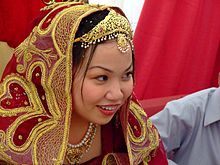Headpiece

A headpiece is an object worn on the head for decoration or protection.
Headpiece may refer to:
- A typically thin metallic crown, headband, or tiara worn around the forehead. Commonly worn by ancient rulers, such as Cleopatra, headpieces usually carry some emblem of religious or political significance.
- A beaded or woven meshwork, often fringed, and worn covering the hair - fascinator.
- The part of a dance or theatrical costume that is worn on the head.
headpiece' Alternative definition (art, crafts, folk-art): Tattooing
A headpiece refers to a design or patterned scheme of artwork purposed for the tattooing of a persons head. The term "headpiece" is widely known in the tradecraft of Tattooing and is found alongside predictable iterations such as "chestpiece", "backpiece", "thighpiece" etc.
The term is verbal artistic shorthand and covers the full range of styles, size, placement and colour work applied by the common variants of electric-powered tattoo machines or by way of "hand-poked" tattooing (tattoo positioned into skin using hand-driven rods or tools). The terminology "headpiece" likely came into common usage as tattoo vernacular through publications such as Billy Tinney's Tattoo magazine (USA) sometime in the Seventies or Eighties. This is anectodal and not historically verifiable due to the low volume of recorded history about the nomenclature around tattooing of the twentieth century, despite its persistent interest as a sub-cultural craft continuously throughout said century.
